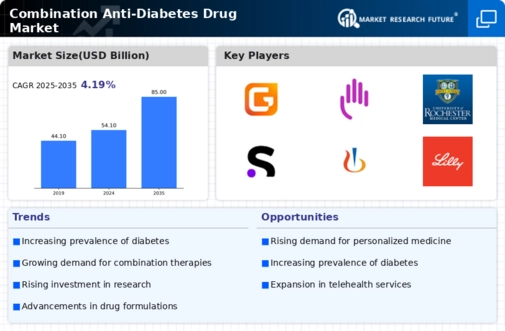Increasing Prevalence of Diabetes
The rising incidence of diabetes worldwide is a primary driver for the Combination Anti-Diabetes Drug Market. According to recent statistics, the number of individuals diagnosed with diabetes has surged, with estimates suggesting that over 500 million people are currently living with the condition. This alarming trend necessitates the development and availability of effective treatment options, including combination therapies that can address multiple aspects of diabetes management. As healthcare providers seek to optimize treatment regimens, the demand for combination anti-diabetes drugs is likely to grow, reflecting a shift towards more comprehensive care strategies. The Combination Anti-Diabetes Drug Market is thus positioned to expand significantly as it responds to the urgent need for innovative solutions to manage this chronic disease.
Shift Towards Value-Based Healthcare
The shift towards value-based healthcare is reshaping the landscape of the Combination Anti-Diabetes Drug Market. Healthcare systems are increasingly focusing on outcomes rather than volume, prompting a reevaluation of treatment approaches for chronic conditions like diabetes. Combination therapies, which can potentially improve patient outcomes and reduce long-term healthcare costs, are becoming more attractive to payers and providers. This trend is likely to drive demand for combination anti-diabetes drugs, as they align with the goals of value-based care by offering effective solutions that enhance quality of life for patients. As the healthcare paradigm continues to evolve, the Combination Anti-Diabetes Drug Market is expected to adapt and thrive in this new environment.
Advancements in Pharmaceutical Research
Ongoing advancements in pharmaceutical research are propelling the Combination Anti-Diabetes Drug Market forward. Innovations in drug formulation and delivery mechanisms have led to the development of more effective combination therapies that enhance patient adherence and treatment outcomes. Research indicates that combination therapies can improve glycemic control and reduce the risk of complications associated with diabetes. Furthermore, the integration of new technologies, such as continuous glucose monitoring and telemedicine, is facilitating the development of personalized treatment plans. As pharmaceutical companies invest in research and development, the Combination Anti-Diabetes Drug Market is likely to witness a surge in novel products that cater to diverse patient needs, thereby expanding market opportunities.
Growing Awareness of Diabetes Management
There is a notable increase in awareness regarding diabetes management, which is significantly influencing the Combination Anti-Diabetes Drug Market. Educational initiatives and public health campaigns are effectively informing patients and healthcare professionals about the importance of early intervention and comprehensive treatment strategies. This heightened awareness is driving demand for combination therapies that can simplify treatment regimens and improve patient outcomes. Market data suggests that regions with robust diabetes education programs are experiencing a faster adoption of combination anti-diabetes drugs. Consequently, the Combination Anti-Diabetes Drug Market is likely to benefit from this trend, as more patients seek effective solutions to manage their condition.
Regulatory Support for Combination Therapies
Regulatory bodies are increasingly supportive of combination therapies, which is fostering growth in the Combination Anti-Diabetes Drug Market. Recent approvals of combination drugs by health authorities reflect a recognition of their potential to enhance treatment efficacy and patient compliance. This regulatory environment encourages pharmaceutical companies to invest in the development of innovative combination therapies that address the multifaceted nature of diabetes. As more combination products receive market authorization, the availability of these therapies is expected to increase, thereby expanding the options for healthcare providers and patients alike. The Combination Anti-Diabetes Drug Market stands to gain from this supportive regulatory landscape, which may lead to accelerated product launches and market penetration.


















Leave a Comment